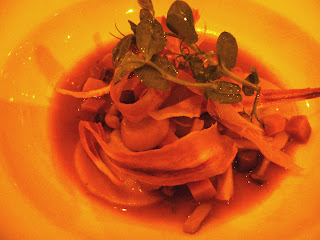Eleven years ago I had my first mangosteen, and then many
more over the course of the few months I spent in Malaysia. Despite some
misgivings about the texture, I thought that it might be my perfect fruit – sweet,
almost rich but with a great juicy, tangy, refreshing quality. I do realize
that this is a ridiculous description of a fruit’s taste – sweet, tangy, rich,
juicy, refreshing – all words that can be used to describe so many kinds of
fruit. I think maybe I mean that it was all these things, but so much more
intensely than any other fruit I’d had. Then I left Malaysia and there were no
more mangosteens, and as far as I could tell, there wouldn’t be for a very long
time, if ever.
When I tried to explain them to people who had never seen or
tasted a mangosteen, I was a little bit at a loss. The outside was easy enough –
very dark purple, the colour and also roughly the size of a ripe granadilla,
but perfectly round and smooth with a stalk. When it came to describing the
inside, though, I couldn’t think how. My best shot was to say that the fruit is
segmented, like a citrus fruit, but with only one big seed in the biggest
segment; and the segments are white. I suppose that does describe what they
look like, but somehow not clearly enough.
Now, eleven years later, we are in Singapore and I have been
reunited with mangosteens. We bought a net bag full last week and as soon as we
were back in our hotel room, I peeled one and gave Andrew one of the segments
before eating one myself; I was so excited for him to try this near-perfect
fruit. Delicious, was his verdict, and “when it’s peeled it looks like a head
of garlic”, he said.
Yes. Yes, it does, a much more concise description.
They are still very good, but the fruit inside the thick
peel is so small, the texture still strange, and I’ve decided I don’t like the segment
with the one big seed at all. I feel a little disappointed in myself that I am
no longer so easily moved to rapturous declarations about fruit, but I suppose
it’s natural to be more given to extremes at seventeen than at twenty-eight.
So in the end, having upheld them as my perfect fruit for
eleven years, mangosteens are making me feel old and a little alienated from my
former self. I must remember in the future not to have quite such high
expectations for fruit.



















